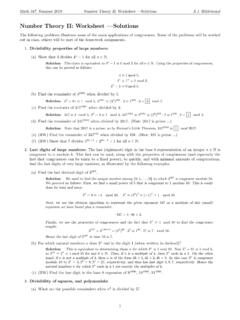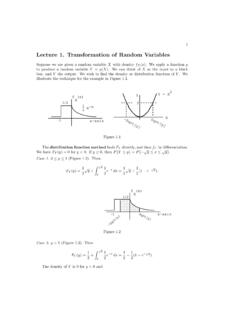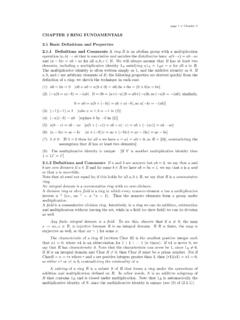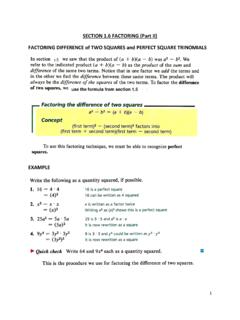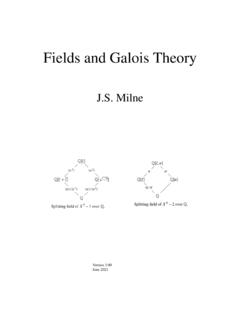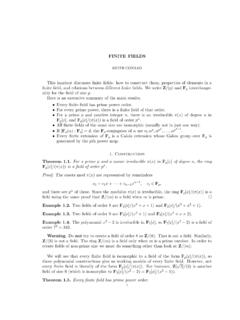Transcription of GaloisTheory - University of Illinois Urbana-Champaign
1 Chapter 6 galois Fixed Fields and galois GroupsGalois theory is based on a remarkable correspondence between subgroups of the Galoisgroup of an extensionE/Fand intermediate fields betweenEandF. In this sectionwe will set up the machinery for the fundamental theorem. [A remark on notation:Throughout the chapter ,the composition of two automorphisms will be written asa product .] Definitions and CommentsLetG= Gal(E/F) be the galois group of the a subgroup ofG,thefixed fieldofHis the set of elements fixed by every automorphism inH ,that is ,F(H)={x E: (x)=xfor every H}.IfKis an intermediate field ,that is ,F K E ,defineG(K) = Gal(E/K)={ G: (x)=xfor everyx K}.I like the term fixing group ofK forG(K) ,sinceG(K) is the group of automorphismsofEthat leaveKfixed. galois theory is about the relation between fixed fields and fixinggroups. In particular ,the next result suggests that the smallest subfieldFcorrespondsto the largest PropositionLetE/Fbe a finite galois extension with galois groupG= Gal(E/F).
2 Then(i) The fixed field ofGisF;(ii) IfHis a proper subgroup ofG ,then the fixed field ofHproperly 6. galois THEORYP roof.(i) LetF0be the fixed field is anF-automorphism ofE ,then bydefinition ofF0, fixes everything inF0. Thus theF-automorphisms ofGcoincide withtheF0-automorphisms ofG. Now by ( ) and ( ),E/F0is galois . By ( ) ,thesize of the galois group of a finite galois extension is the degree of the extension. Thus[E:F]=[E:F0] ,so by ( ) ,F=F0.(ii) Suppose thatF=F(H). By the theorem of the primitive element ( ) ,wehaveE=F( ) for some E. Define a polynomialf(X) E[X]byf(X)= H(X ( )).If is any automorphism inH ,then we may apply tof(that is ,to the coefficients off;we discussed this idea in the proof of ( )). The result is( f)(X)= H(X ( )( )).But as ranges over all ofH ,so does ,and consequently f=f. Thus each coefficientoffis fixed byH ,sof F[X].
3 Now isarootoff ,sinceX ( ) is 0 whenX= and is the identity. We can say two things about the degree off:(1) By definition off ,degf=|H|<|G|=[E:F] ,and ,sincefis a multiple of theminimal polynomial of overF,(2) degf [F( ):F]=[E:F] ,and we have a contradiction. There is a converse to the first part of ( ). PropositionLetE/Fbe a finite extension with galois groupG. If the fixed field ofGisF ,thenE/Fis { 1,.., n} ,where 1is the identity. To show thatE/Fis normal,we consider an irreducible polynomialf F[X] with a root E. Apply each au-tomorphism inGto ,and suppose that there arerdistinct images = 1= 1( ), 2= 2( ),.., r= r( ). If is any member ofG ,then will map each ito some j ,and since is an injective map of the finite set{ 1,.., r}to itself ,it is surjective aswell. To put it simply, permutes the i. Now we examine what does to theelementarysymmetric functionsof the i ,which are given bye1=r i=1 i,e2= i<j i j,e3= i<j<k i j k.
4 ,er=r i=1 permutes the i ,it follows that (ei)=eifor alli. Thus theeibelong to thefixed field ofG ,which isFby hypothesis. Now we form a monic polynomial whose rootsare the i:g(X)=(X 1) (X r)=Xr e1Xr 1+e2Xr 2 +( 1) FIXED FIELDS AND galois GROUPS3 Since theeibelong toF,g F[X] ,and since the iare inE,gsplits overE. We claimthatgis the minimal polynomial of overF. To see this ,leth(X)=b0+b1X+ +bmXmbe any polynomial inF[X] having as a root. Applying ito the equationb0+b1 + bm m=0we haveb0+b1 i+ bm mi=0,so that each iisarootofh ,hencegdivideshand thereforeg=min( ,F). But ouroriginal polynomialf F[X] is irreducible and has as a root ,so it must be a constantmultiple ofg. Consequently,fsplits overE ,proving thatE/Fis normal. Since the i,i=1,..r ,are distinct ,ghas no repeated roots. Thus is separable overF ,which showsthat the extensionE/Fis separable. It is profitable to examine elementary symmetric functions in more TheoremLetfbe a symmetric polynomial in thenvariablesX1.
5 ,Xn. [This means that if isany permutation inSnand we replaceXibyX (i)fori=1,..,n ,thenfis unchanged.]Ife1,..,enare the elementary symmetric functions of theXi ,thenfcan be expressedas a polynomial in give an algorithm. The polynomialfis a linear combination of monomialsof the formXr11 Xrnn ,and we order the monomials lexicographically:Xr11 Xrnn>Xs11 Xsnniff the first disagreement betweenriandsiresults inri>si. Sincefissymmetric ,all terms generated by applying a permutation Snto the subscripts ofXr11 Xrnnwill also contribute tof. The idea is to cancel the leading terms (thoseassociated with the monomial that is first in the ordering) by subtracting an expressionof the formet11et22 etnn=(X1+ +Xn)t1 (X1 Xn)tnwhich has leading termXt11(X1X2)t2(X1X2X3)t3 (X1 Xn)tn=Xt1+ +tn1Xt2+ +tn2 will be possible if we chooset1=r1 r2,t2=r2 r3.
6 ,tn 1=rn 1 rn,tn= subtraction ,the resulting polynomial has a leading term that is belowXr11 Xrnnin the lexicographical ordering. We can then repeat the procedure ,which must terminatein a finite number of steps. 4 CHAPTER 6. galois CorollaryIfgis a polynomial inF[X] andf( 1,.., n) is any symmetric polynomial in the roots 1,.., nofg ,thenf F[X]. may assume without loss of generality thatgis monic. Then in a splittingfield ofgwe haveg(X)=(X 1) (X n)=Xn e1Xn 1+ +( 1) ( ),fis a polynomial in theei ,and since theeiare simply the coefficients ofg,the coefficients offare inF. Dedekind s LemmaThe result that the size of the galois group of a finite galois extension is the degree ofthe extension can be proved via Dedekind s lemma ,which is of interest in its own a group andEa field. AcharacterfromGtoEis a homomorphism fromGto the multiplicative groupE of nonzero elements ofE.
7 In particular ,an automorphismofEdefines a character withG=E ,as does a monomorphism ofEinto a s lemma states that if 1,.., nare distinct characters fromGtoE ,then the iare linearly independent overE. The proof is given in Problems 3 and For Section ExpressX21X2X3+X1X22X3+X1X2X23in terms of elementary symmetric Repeat Problem 1 forX21X2+X21X3+X1X22+X1X23+X22X3+X2X23+ To begin the proof of Dedekind s lemma ,suppose that the iare linearly renumbering the iif necessary ,we havea1 1+ ar r=0where allaiare nonzero andris as small as possible. Show that for everyhandg G,we haver i=1ai 1(h) i(g) = 0(1)andr i=1ai i(h) i(g)=0.(2)[Equations (1) and (2) are not the same; in (1) we have 1(h) ,not i(h).]4. Continuing Problem 3 ,subtract (2) from (1) to getr i=1ai( 1(h) i(h)) i(g)=0.(3)Withgarbitrary ,reach a contradiction by an appropriate choice THE FUNDAMENTAL THEOREM55.
8 IfGis the galois group ofQ(3 2) overQ ,what is the fixed field ofG?6. Find the galois group Find the fixed field of the galois group of Problem The Fundamental TheoremWith the preliminaries now taken care of ,we can proceed directly to the main Fundamental Theorem of galois TheoryLetE/Fbe a finite galois extension with galois a subgroup ofG,letF(H) be the fixed field ofH ,and ifKis an intermediate field ,letG(K) be Gal(E/K),the fixing group ofK(see ( )).(1)Fis a bijective map from subgroups to intermediate fields ,with inverseG. Both mapsare inclusion-reversing ,that is ,ifH1 H2thenF(H1) F(H2) ,and ifK1 K2,thenG(K1) G(K2).(2) Suppose that the intermediate fieldKcorresponds to the subgroupHunder theGalois correspondence. Then(a)E/Kis always normal (hence galois );(b)K/Fis normal if and only ifHis a normal subgroup ofG ,and in this case ,(c) the galois group ofK/Fis isomorphic to the quotient groupG/H.
9 Moreover,whether or notK/Fis normal,(d) [K:F]=[G:H] and [E:K]=|H|.(3) If the intermediate fieldKcorresponds to the subgroupHand is any automorphisminG ,then the field K={ (x):x K}corresponds to the conjugate subgroup H 1. For this reason, Kis called aconjugate following diagram may aid the ||KH||F1As we travel up the left side from smaller to larger fields ,we move down the right sidefrom larger to smaller groups. A statement aboutK/F ,an extension at the bottom ofthe left side ,corresponds to a statement aboutG/H ,located at the top of the right ,a statement aboutE/Kcorresponds to a statement aboutH/1= (1) First ,consider the composite mappingH F(H) GF(H). If Hthen fixesF(H) by definition of fixed field ,and therefore GF(H) = Gal(E/F(H)). ThusH GF(H). If the inclusion is proper ,then by ( ) part (ii) withFreplaced byF(H),6 CHAPTER 6. galois THEORYwe haveF(H)>F(H) ,a contradiction.
10 [Note thatE/Kis a galois extension for anyintermediate fieldK ,by ( ) and ( ).] ThusGF(H)= consider the mappingK G(K) FG(K)=FGal(E/K). By ( ) part (i)withFreplaced byK ,we haveFG(K)=K. Since bothFandGare inclusion-reversingby definition ,the proof of (1) is complete.(3) The fixed field of H 1is the set of allx Esuch that 1(x)=xfor every ( H 1)={x E: 1(x) F(H)}= (F(H)).(2a) This was observed in the proof of (1).(2b) If is anF-monomorphism ofKintoE ,then by ( ) and ( ) , extendsto anF-monomorphism ofEinto itself ,in other words (see ( )) ,anF-automorphismofE. Thus each such is the restriction toKof a member ofG. Conversely ,therestriction of an automorphism inGtoKis anF-monomorphism ofKintoE. By ( )and ( ),K/Fis normal iff for every Gwe have (K)=K. But by (3), (K)corresponds to H normal iff H 1=Hfor every G, ,H G.(2c) Consider the homomorphism ofG= Gal(E/F) to Gal(K/F) given by | map is surjective by the argument just given in the proof of (2b).
